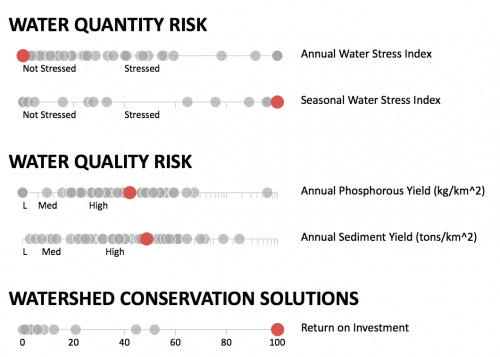Teams Like This
As human populations grow, issues of water quality and quantity arise in cities. However, governments, corporations and multilateral banks often look to build costly infrastructure, such as dams and reservoirs, to solve these problems instead of investing in natural ways to secure clean water and mitigate flood risk. These key actors often have knowledge and tools to quantify expected gains from engineered solutions, but largely lack information to understand how natural solutions, such as watershed protection, can enhance water security.
OUR APPROACH: This working group explored costs of urban water security and developed tools for key stakeholders to evaluate water quality risk, watershed conservation solutions, and flood mitigation in Latin America. With this, decision makers can get a better idea of how to maximize returns on major nature-based investments for water security in Latin America.

Conserving Nature for Water Security Interactive Tool
This interactive dashboard allows key stakeholders, such as the Latin American Conservation Council and Inter-American Development Bank, to explore urban water source risks and beneficial conservation efforts. The tool provides metrics for population, water quantity flood mitigation, water quality riparian restoration, and reforestation. The resulting analysis and comparisons will help policymakers evaluate the strengths and limitations of watershed strategies in major Latin American cities. Of all cities included in the dashboard, the city of Bucaramanga had the highest potential return on investment (ROI) for watershed conservation, as shown in the image to the right.
Water Conservation Screening Tool
This online tool allows users to quickly measure the potential for five common watershed conservation activities to reduce sediment and nutrient pollution in a source watershed. This tool will describe land cover and estimate pollutant loading for each source watershed. It will also show the amount of conservation effort (in area or cost) needed to achieve a 1%, 5%, 10%, and 20% pollution reduction.

“Nature is a cost-effective solution for 17 out of 64 major cities in Latin America; 60 million people could potentially benefit. These are arguably a slam dunk – a strong business case for nature regardless of other benefits that nature provides.”
– Josh Goldstein, Team Lead
The China Urban Water Blueprint analyzes the state of the 135 surface water sources tapped by the country’s 30 largest and fastest growing cities.
The City Water Map (CWM) database contains information on the water sources for cities internationally.
This paper in Environmental Science and Policy explores the potential for increasing the uptake and impact of investments in watershed services (IWS).
This study provides decision makers with some first steps in considering watershed conservation to control floods or improve water quality in urban areas of Latin America. Despite its geographic focus, the principles it outlines are relevant anywhere.
Yale University
The Nature Conservancy
The Nature Conservancy
Development Bank of Latin America
Natural Capital Project and The World Bank Group
The Nature Conservancy
Inter-American Development Bank
The Nature Conservancy
The Nature Conservancy
Stanford University
The Nature Conservancy